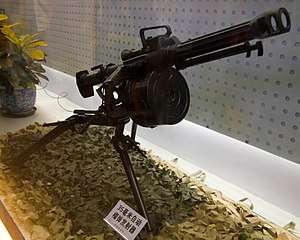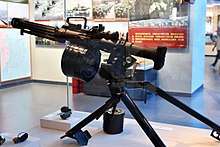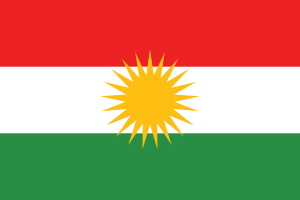QLZ-87 grenade launcher
The QLZ-87[7][8][9] (also known as Type 87[10]) 35 mm automatic grenade launcher (AGL)[11] is an air-cooled, gas operated[12] fully automatic weapon and is crew transportable (12~20 kg) with limited amounts of ammunition.[13]
| QLZ-87 (Type 87 Grenade Launcher) | |
|---|---|
 A Type 87 grenade launcher mounted on a tripod on display in Beijing | |
| Type | Grenade launcher |
| Place of origin | China |
| Service history | |
| Wars |
|
| Production history | |
| Designer | Xiafeng Machinery[5] |
| Designed | Mid 1980s |
| Manufacturer | Norinco |
| Produced | Late 1980s – present |
| Specifications | |
| Mass | 26 lb (12 kg) (Light with scope) 44 lb (20 kg) (Heavy with scope) |
| Length | 38 in (970 mm) |
| Cartridge | 35×32 mm grenade |
| Action | Air cooling, gas-operated (direct impingement) |
| Rate of fire | 480 rounds/min |
| Muzzle velocity | 190 m/s (620 ft/s) |
| Effective firing range | 600 m |
| Maximum firing range | 1,750 m (tripod-mounted) |
| Feed system | 6- or 15-round drum magazine |
| Sights | Iron sights 3x magnification optic Optic mounting rail for night vision or thermal sight[6] |
The QLZ-87 is being complemented by the QLZ-04, which is fed from a belt and thus is better suited to be mounted on tripods and vehicles.[14]
Development
The Chinese military began research into grenade launchers during the 1980s. They started off by examining American weapons captured in the Vietnam War including the 40×46mm single-shot M79 and M203; they were also familiar with the hand-cranked Mk 18, as well as the 40×53mm XM75 and Mk 19. China also obtained samples of the Soviet 30×29mm AGS-17 captured by the Mujahideen during the Soviet–Afghan War. The Hua Dong Industrial Academy’s Mechanical Research Institute, a state-controlled civilian organization that carried out China's AGL development, concluded that such foreign weapons were too large and heavy to be man-portable and did not fit within doctrinal deployment plans for the system. They also had problems with each sides' ammunition; the U.S. grenade's advanced primer ignition (API) operating principle was less reliable than desired, and the Soviet grenade was too small to contain an effective high-explosive anti-tank (HEAT) warhead, so the team compromised on a 35 mm cartridge.[15]
After five generations of prototypes, the team created a design designated the W87.[15] The W87 featured a roller-delayed blowback operation and fired from a closed bolt for better accuracy. It could be top-loaded from 6- and 9-round box magazines or a 12-round drum magazine. A bipod was included for quick deployment and it could be tripod-mounted. The 35×32mm grenades had an aluminum case and round nose. The W87 and its ammunition were revealed in a presentation at a small arms development conference hosted at Aberdeen Proving Ground in September 1988.[16] After some redesigns, the AGL was accepted into Chinese military service as the QLZ-87 in the mid-1990s.[17]
Design
.jpg)

The QLZ-87 is in fact a derivative of the Type 85 heavy machine gun, featuring a similar tubular steel receiver, direct gas impingement operation, and flap locks (derived from the Degtyarov-Shpagin system featured on the DShK machine gun). It is magazine-fed from 6- or 15-round drums from the bottom; in order to make room for ammunition to be fed from the bottom, the fire selector controls are mounted on the right side and offer safe, semi-automatic, and automatic firing modes. The grenade launcher retains the bipod of the W87 and weighs the same at 12 kg (26 lb) with an 8 kg (18 lb) tripod, though the new tripod has articulated legs and a crank elevation adjustment. Its carrying handle is an external part of the bolt group, which is cycled by redirected propellant gas as part of the operating system, but unlike the M16 rifle propellant gasses are not vented into the receiver; it also functions as the charging handle and forward assist.[17] Once the bolt group starts to recoil, remaining gasses are immediately vented outward and spent cases are ejected directly upwards. To manage recoil the weapon has a large, twin-port muzzle brake, thick rubber butt pad, and an internal buffer to the rear of the bolt group, but recoil is still harsh and only semi-automatic fire is viable when not mounted.[18]
While American and Russian AGLs are heavy, crew-served tripod-mounted weapons employed at battalion-level, the QLZ-87 in its "light" configuration can be used by one soldier from the shoulder or bipod as a company-level support weapon. In this configuration it is typically fired semi-automatically and fed from the 6-round drum. In its "heavy" configuration (which includes the tripod) it is carried by a crew of three, and can make effective use of the 15-round drum and fully automatic fire. Like heavier AGLs it can be pintle-mounted on vehicles, but troop feedback indicates mounted magazine reloading is both difficult, and frequent because of the low ammunition capacity.[19][20]
Ammunition
The 35×32mm grenade was also redesigned for the QLZ-87, giving it a shorter overall length with a tapered, flat nosed projectile housed in a semi-rimmed aluminum case. It weighs roughly the same at 250 grams (8.8 oz) and has a slightly faster muzzle velocity of 190 m/s; a 6-round drum weighs 1.3 kg (2.9 lb) empty and 2.8 kg (6.2 lb) loaded, and a 15-round drum weighs 2.3 kg (5.1 lb) empty and 6 kg (13 lb) loaded. The two most common types of grenades are the DFS87 high explosive (HE), which has a fragmentation warhead with a casualty radius of 10-11 meters, and the DFJ87 high explosive dual purpose (HEDP), which has a shaped charge warhead that can penetrate 80 mm of rolled homogeneous armor (RHA) which striking flat or 35 mm of RHA at a 60° angle with a secondary 5-meter fragmentation casualty radius;[21] though both these rounds have better anti-personnel and armor piercing effects individually than U.S. 40 mm HEDP, their specialization makes them less suited for defeating a different target set, so ammunition type would have to be changed to effectively engage a different target type.[20][22] Initial production of both models featured a fragmentation liner consisting of small steel balls suspended in a polymer matrix, but later the HE projectile used a pre-fragmented wire coil jacket and the HEDP projectile used a steel upper casing to produce fragments, both for cost savings. They have an inertia-armed fuze in the nose permitting a safe arming distance of 12–30 meters from the muzzle. Other available 35 mm cartridges include the DFR87 incendiary, DFN87 high-explosive incendiary (HEI), and DFD87 smoke.[21]
Variants
Users












See also
| Wikimedia Commons has media related to QLZ87. |
- QLZ-04
- QLU-11, replacement of QLZ-87
- Type 91 grenade launcher
- Milkor MGL
- Neopup PAW-20
References
- Small Arms Survey (2014). "Weapons tracing in Sudan and South Sudan" (PDF). Small Arms Survey 2014: Women and guns (PDF). Cambridge University Press. p. 226.
- Yan 2014, p. 8
- Savannah de Tessières (January 2018). At the Crossroads of Sahelian Conflicts: Insecurity, Terrorism, and Arms Trafficking in Niger (PDF) (Report). Small Arms Survey. p. 58. ISBN 978-2-940548-48-4.
- Smallwood, Michael (29 April 2016). "Kurdish Forces with Chinese QLZ87 Automatic Grenade Launcher & M99 Anti-materiel Rifle". Small Arms Defense Journal. Vol. 8 no. 1.
- https://web.archive.org/web/20100503004005/http://www.xian-feng.net/index.htm
- Yan 2014, p. 15.
- Yan 2014, p. 22.
- https://ndiastorage.blob.core.usgovcloudapi.net/ndia/2010/armament/WednesdayLandmarkBJuanjuanYang.pdf
- "35x32mm Type 87 - Weaponsystems.net". weaponsystems.net.
- Small Arms Survey 2014, p. 240.
- "QLZ-87 / W87 - Modern Firearms". modernfirearms.net. 28 October 2010.
- "Archived copy". Archived from the original on 2 June 2013. Retrieved 2 June 2013.CS1 maint: archived copy as title (link) Sino Defence, QLZ87 35mm Automatic Grenade Launcher
- Blasko, Dennis J. (17 June 2013). The Chinese Army Today: Tradition and Transformation for the 21st Century. Routledge. p. 168. ISBN 978-1-136-51997-0.
- Yan 2014, p. 18.
- Yan 2014, p. 11.
- Yan 2014, p. 12.
- Yan 2014, p. 13.
- Yan 2014, p. 14.
- Yan 2014, p. 7.
- QLZ87 Weapon Systems.
- Yan 2014, p. 16.
- 35×32mm Type 87 Weapon Systems.
- "QLB-06 / QLZ-87B - Modern Firearms". modernfirearms.net. 28 October 2010.
- IDEX ABU 2017 Small Arms Defense Journal. 17 November 2017.
- Yan, Timothy (August 2014). The Chinese QLZ87 Automatic Grenade Launcher (PDF). Arms & Munitions Brief 1. Armament Research Services Pty. Ltd. ISBN 9780992462420.